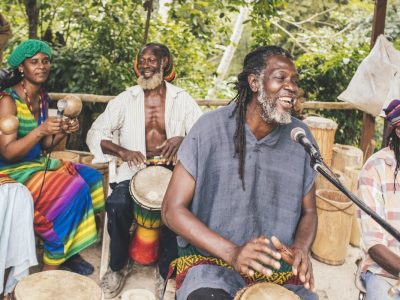The making of the Rastafari movement can be seen in two parts: restoring the dignity of black people that slavery and colonisation had stripped from them and setting them on a spiritual path that was not dictated by the white church.
Whilst Marcus Garvey focused on the former as a Catholic, he was unable to offer an alternative to the white man’s religion. In his endorsement of modern ways of thinking, he neglected the religious needs of millions of his followers. In 1921 his Universal Negro Improvement Association created the African Orthodox Church, but Black people didn’t want to worship a version of a messianic Christ who was tortured to death on a cross amongst thieves.
So, who were the Rasta forerunners who offered spiritual healing to the former enslaved, and who was the first Rasta?
On 2 November 1930, Ras Tafari Makonnen ascended to the throne as Emperor Haile Selassie I of Ethiopia. Considered a descendant of King Solomon and the Queen of Sheba, he took on the titles King of Kings, Lord of Lords, and Conquering Lion of the Tribe of Judah. Many saw his coronation as fulfilling a Biblical prophecy about a black king.
In Jamaica, preachers started endorsing Selassie’s sovereignty over King George V. By the mid-1930s, followers considered the Ethiopian emperor to be a living representation of God.
Henry Archibald Dunkley
Archibald Dunkley was a Jamaican seaman on the Atlantic Fruit Company’s boats. He quit the sea on the 8th December 1930, when he landed at Port Antonio off the SS ‘St. Mary’. Dunkley moved to Kingston, where he studied the Bible for two-and-a-half years on his own to determine whether Haile Selassie was the Messiah whom Garvey had prophesied. Ezekiel 30, I Timothy 6, Revelation 17 and 19 and Isaiah 43 finally convinced him. In 1933, Dunkley established his Mission, proclaiming Ras Tafari as the King of Kings, the Root of David, the Son of the living God, but not the Father Himself.
He was arrested several times in 1934–35 and eventually spent six months in an asylum.
Joseph Nathaniel Hibbert
Another early preacher was Joseph Nathaniel Hibbert. Hibbert was born in Jamaica in 1894 but went with his adopted father to Costa Rica in 1911, returning to Jamaica in 1931. In Costa Rica, Hibbert had leased 28 acres, where he grew bananas. In 1924 he joined the Ancient Mystic Order of Ethiopia, a Masonic society the constitution of which was revised in 1888 and which became incorporated in 1928 in Panama.
Hibbert became a Master Mason of this Order. On his return to Jamaica, at Benoah District, St Andrew he began to that preach Haile Selassie, as the King of Kings, was the returned Messiah and the Redeemer of Israel. He eventually moved to Kingston, where he found Leonard Percival Howell already preaching Ras Tafari as God at the Redemption Market.
Leonard Percival Howell

Leonard Percival Howell was born on 16 June 1898 in Red Lands, Clarendon, Jamaica. He is considered to be the first Rasta and suffered greatly for the founding of the movement.
At the age of 14, Howell moved to New York. His father wanted him to be a doctor, but young Leonard didn’t feel he was cut out for it, so his father abandoned him and cut off his allowance. Leonard went from job to job until he met an American army colonel named Aites. Leonard travelled across the globe with Aites, from Asia to Europe. He made several visits to Panama, a place where there was a great mix of ideas and nationalities working there at different times.
Howell’s experiences introduced him to Pan-Africanism, Marxism, Communism, and diverse forms of Black Nationalism. While in New York, he became part of the Universal Negro Improvement Association (UNIA), established by fellow Jamaican Marcus Garvey in 1914. Garvey’s ideology had a significant impact on Howell. But while he was clearly influenced by Garvey’s thinking, Howell had a mixed relationship with Garvey, a Christian, who later criticised the budding Rastafari movement as a “cult.”
Leonard returned to Jamaica in 1932 and was appalled at the standard of living of the black people. One hundred four years after slavery, there was still no relief for many black people. They were penniless and abandoned by the governing British.
Once back home, accompanied by some of his followers, he started spreading the Rastafarian message across the island, preaching the superiority of the Black race and the divinity of Haile Selassie I, the returned Messiah to earth. He financed his mission by selling pictures of the Emperor as passports. He also raised funds by treating sick people who came to him for miracle cures.
His eloquence and worldly knowledge not only captivated the Jamaican lower class but also drew the attention of local authorities. In 1934 he was arrested for sedition for preaching that Emperor Haile Selassie of Ethiopia (Ras Tafari) was the Messiah and that Black people were the chosen people.
Leonard Howell became the first to be persecuted and charged with sedition for refusing loyalty to the King of Great Britain and Ireland, George V. The British government would not tolerate Jamaicans loyal to Haile Selassie in what was then a British colony. Howell was sent to prison for two years for sedition. His trial was well publicised, making him a martyr.





